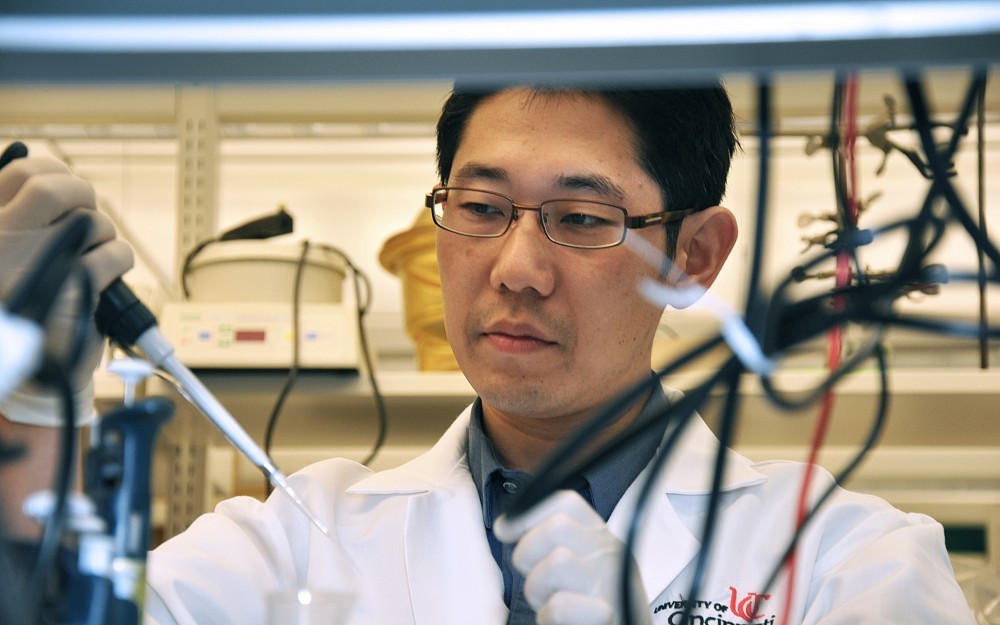
Researcher Awarded $50K Grant for Study of Energy Pathway in Glioblastoma
The highly malignant glioblastoma brain cancer is an energy guzzler. To sustain the tumors rapid cell division and proliferation, glioblastoma cells harness a specific molecule that enables them to ramp up energy production.
What if that energy spigot could be turned off and glioblastoma cells ran out of fuel? It is an idea so intriguing that the American Brain Tumor Association (ABTA) has awarded a $50,000 grant to Atsuo Sasaki, PhD, to find out.
Sasaki, assistant professor in the division of hematology oncology at the University of Cincinnati College of Medicine, will work with members of his lab at the UC Brain Tumor Center to test whether they can interfere with the disregulated energy molecule, guanosine triphosphate (GTP), and suppress the GTP pathway.
"This award means a lot to me, because a national foundation has recognized our work, Sasaki says.
"The ABTA research award is a tribute to Dr. Sasaki, his laboratory team and the vision of the UC Brain Tumor Center, says Ronald Warnick, MD, medical director of the center and the John M. Tew, Jr., MD, Chair in Neurosurgical Oncology at UC. "We are determined to bring hope to our patients through translational research that moves science forward and leads us in the direction of new, life-saving therapies.
The Brain Tumor Center is part of the UC Neuroscience Institute and the UC Cancer Institute, which are part of the UC College of Medicine and UC Health.
The ABTA grant presents Sasaki with an opportunity to explore his theory of energy utilization in cancer cells, which he developed after coming to the UC Brain Tumor Center in 2012.
Sasaki likens brain tumors to large, gas-guzzling vehicles that use lots of fuel to get where they need to go. "And, like gas-guzzling vehicles, he says, "brain cancer cells require frequent trips to the gas station to fill up their tank.
This need to continually refuel is a vulnerability that offers a potential opportunity to scientists, he says. "If we can keep the tumor cells from acquiring more fuel, they will expire. We know that if this system is disruptedif the cells run out of gasthey are going to die.
Pharmacological inhibition of the GTP pathway, Sasaki adds, is unlikely to affect normal brain cells. Unlike glioblastoma cells, normal brain cells utilize a distinctive, fuel-efficient energy metabolism and should be able to maintain their energy levels.
Sasakis immediate objective is to understand how suppression of the brain tumor-specific energy pathway impacts glioblastoma cells, cultured in a petri dish, and in a rodent model of glioblastoma. Sasaki theorizes that a "bottleneck target in the energy pathway plays a role in the generation of GTP in glioblastoma cells.
The results of his investigation could prove significant. They could clarify the molecular link between glioblastoma and high GTP energy production. "Our research could result in a new and powerful strategy for the treatment of glioblastoma, Sasaki says.
The approach also could become a therapy for metastatic brain tumors, which, like glioblastoma, are aggressive, energy-guzzling tumors.
The ultimate goal of Sasakis laboratory research is to acquire new knowledge that the UC Brain Tumor Centers clinical team can translate into phase-1 and -2 clinical trials for patients.
Related Stories
Is ketamine the answer to treatment-resistant depression?
May 16, 2024
The University of Cincinnati's Stephen Rush joined WVXU's Cincinnati Edition to discuss the use of ketamine and esketamine to treat treatment-resistant depression.
UC study: Severe ischemic strokes rare in total patient...
May 15, 2024
The University of Cincinnati’s Yasmin Aziz will present research at the European Stroke Organisation Conference that found severe ischemic strokes with the most severe damage are rare in the total stroke patient population.
Increasing syphilis cases highlight treatment barriers across...
May 14, 2024
The University of Cincinnati's Carl Fichtenbaum spoke with the Cincinnati Enquirer about a recent report that found Hamilton County syphilis cases reached a six-year high in 2023.
